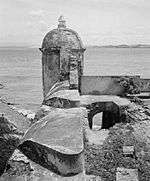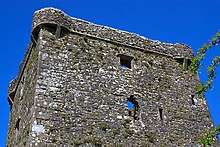Bartizan

A bartizan, (an alteration of bratticing), also called a guerite or échauguette, or spelled bartisan, is an overhanging, wall-mounted turret projecting from the walls of late medieval and early-modern fortifications from the early 14th century up to the 18th century.[1] Most frequently found at corners, they protected a warder and enabled him to see his surroundings. Bartizans generally are furnished with oillets or arrow slits.[2] The turret was usually supported by stepped masonry corbels and could be round, polygonal or square.[3]
Bartizans were incorporated into many notable examples of Scots Baronial Style architecture in Scotland. In the architecture of Aberdeen, the new Town House, built in 1868–74, incorporates bartizans in the West Tower.
Gallery
- Guarita at Fortaleza de Santiago, Sesimbra Municipality, Portugal.


 South-East Bartizan on Greenknowe Tower, Scottish Borders (and another one in the background)
South-East Bartizan on Greenknowe Tower, Scottish Borders (and another one in the background).jpg) Line drawing of a bartizan
Line drawing of a bartizan
 Garita at [[Castillo San Cristóbal (San Juan)|]] in San Juan, Puerto Rico.
Garita at [[Castillo San Cristóbal (San Juan)|]] in San Juan, Puerto Rico.
.jpg)
 Devil's Sentry Box, or the "Garita del Diablo", San Cristóbal Castle, in San Juan, Puerto Rico.
Devil's Sentry Box, or the "Garita del Diablo", San Cristóbal Castle, in San Juan, Puerto Rico. Bartizans at Feartagar Castle, Ireland.
Bartizans at Feartagar Castle, Ireland.
See also
| Look up bartizan, bartisan, échauguette, or guerite in Wiktionary, the free dictionary. |
References
- ↑

- ↑

- ↑ Bradley, Simon, ed. (2010). Pevsner's Architectural Glossary. Yale University Press. p. 33. ISBN 978-0-300-16721-4.
External links
| Wikimedia Commons has media related to Bartizans. |